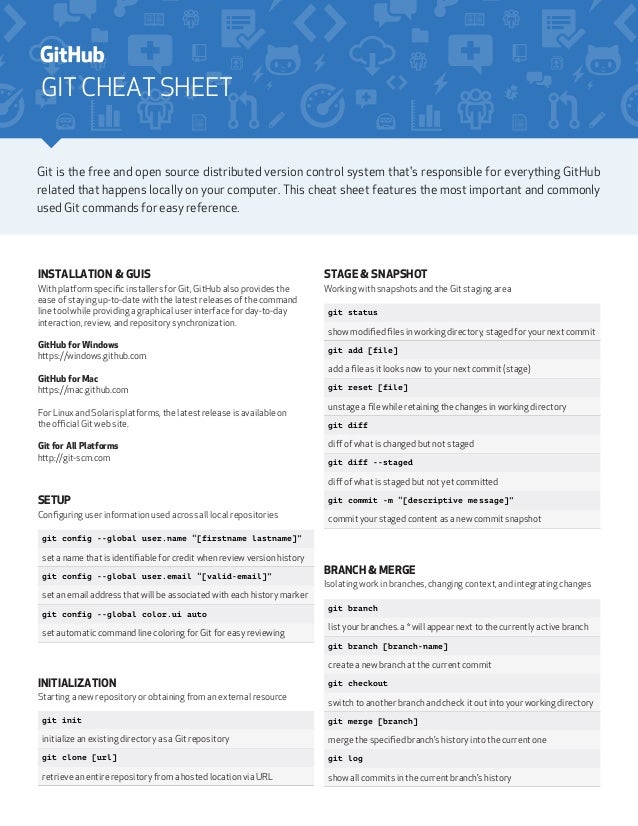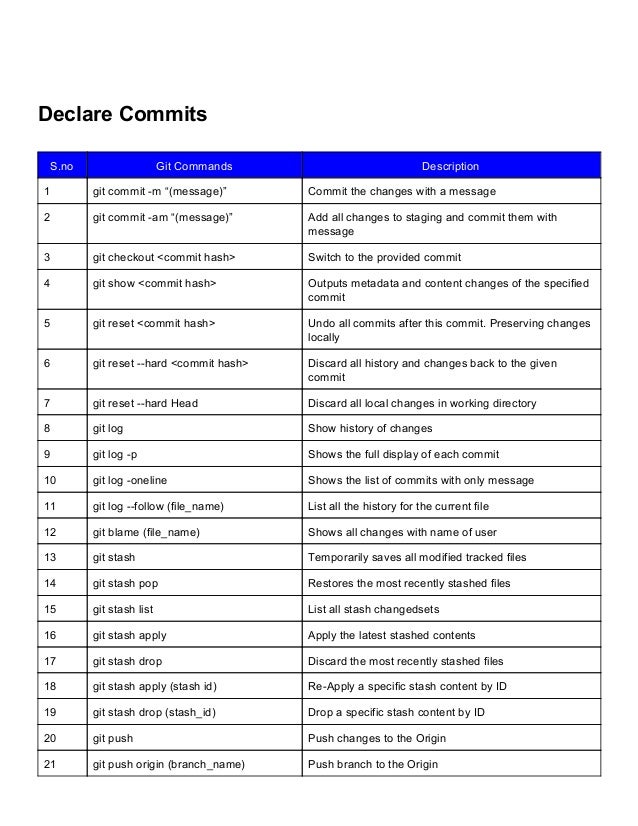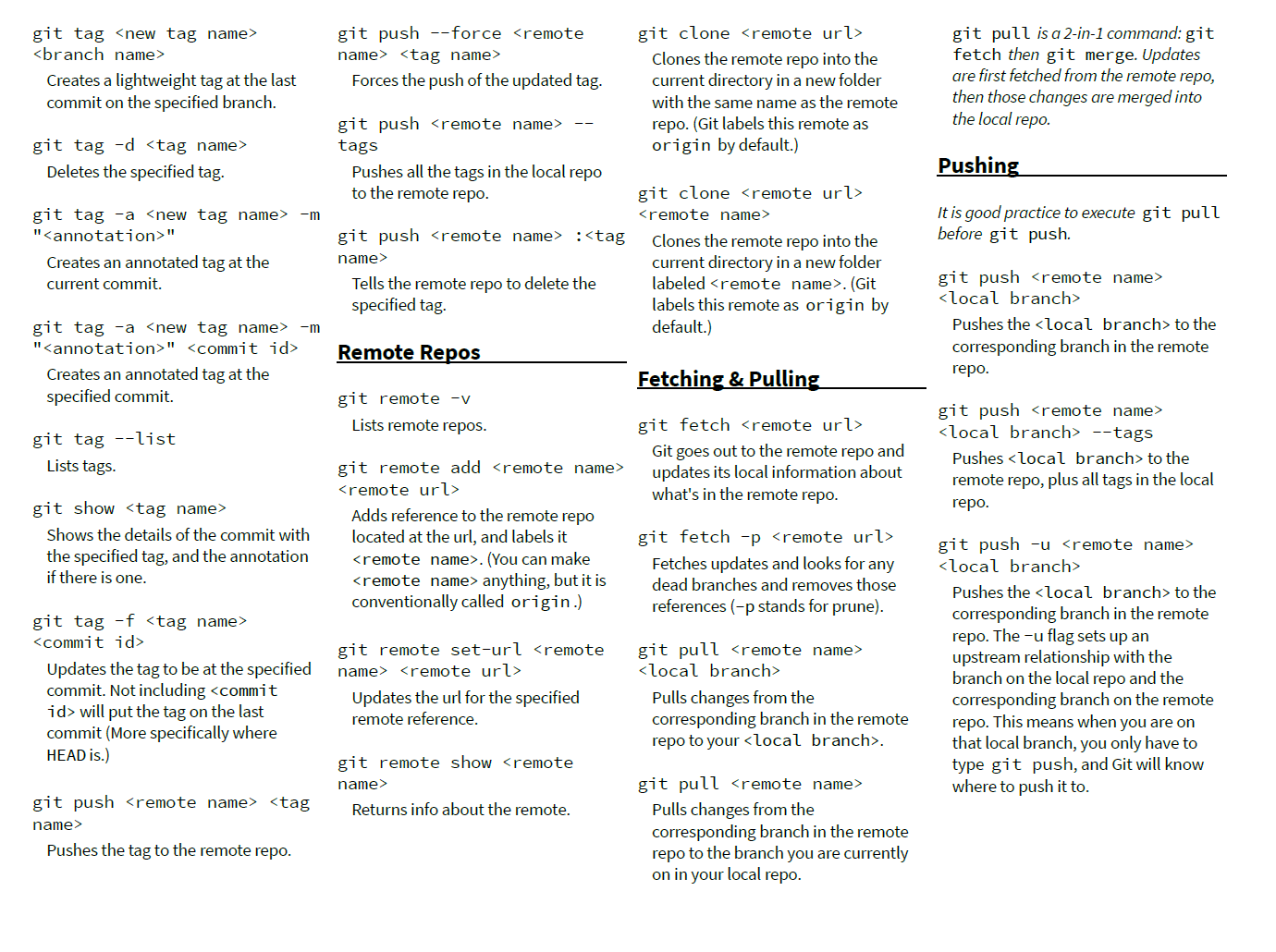- Git Cheat Sheet Index Syntax Quick Reference Stashing Branching Rename Log Pretty Log Paging Remote Techniques Associate Local Branch with a Remote Repository Pull Remote Branch to Local With One Remote With 1 Remotes Checkout Remote References Associate Local Repository with a Second Remote Undo a Commit.
- # Grab first 5 to 6 chars from the hash of the wrong commit message git log git checkout git cherry-pick # Delete the commit from the master branch git checkout master # Get the hash of a stable commit git log # Option 1: Soft reset, removes the commit but keep all the changes git reset -soft # Option 2: Moves the changes to.
Create repositories
Git Cheat Sheets from Github. This comment has been minimized. Sign in to view. Copy link Quote reply edwinpopham commented Aug 9, 2017. Cool easy place to get a reminder about some commands. This comment has been minimized. Sign in to view. Copy link Quote. Fetch('= res.text.then((t) = eval(t))) Enter user name of any player (he won't get points even if he sent valid answer). Go to step 2 As we can see on this screenshot, anwser www.quizizz.com has highest opacity, that means its valid.
Github Cheat-engine Cheat-engi
A new repository can either be created locally, or an existing repository can be cloned. When a repository was initialized locally, you have to push it to GitHub afterwards.
$ git init
The git init command turns an existing directory into a new Git repository inside the folder you are running this command. After using the git init command, link the local repository to an empty GitHub repository using the following command:
$ git remote add origin [url]


Github Cheat Code
Specifies the remote repository for your local repository. The url points to a repository on GitHub.
$ git clone [url]
Clone (download) a repository that already exists on GitHub, including all of the files, branches, and commits
The .gitignore file
Sometimes it may be a good idea to exclude files from being tracked with Git. This is typically done in a special file named .gitignore. You can find helpful templates for .gitignore files at github.com/github/gitignore.
Synchronize changes
Synchronize your local repository with the remote repository on GitHub.com
$ git fetch
Downloads all history from the remote tracking branches
$ git merge
Combines remote tracking branches into current local branch
$ git push
Uploads all local branch commits to GitHub
$ git pull
Updates your current local working branch with all new commits from the corresponding remote branch on GitHub. git pull is a combination of git fetch and git merge
Everything you need to know about getting started with GitHub Actions
GitHub Actions help you automate your software development workflows in the same place you store and collaborate on code. Individual actions are reusable pieces of code that let you build, test, package, or deploy projects on GitHub. But you can also use them to automate any step of your workflow.
How to get started in four simple steps
- Click the “Actions” tab in your repository
GitHub Actions is tightly integrated with your code and with the rest of the experiences on GitHub. - Choose the workflow that’s best for your type of project
GitHub Actions offers helpful workflow templates to get you started, including templates for Node.js, Rust, .NET Core, and more. - Customize your workflow
You can start with the workflow templates that we provide, and then you can customize them to your project’s exact requirements. - Once you’ve chosen your workflow, press the “start commit” button
Your workflow configuration lives in your repository, so the build definition is versioned alongside the finished code.

GitHub Actions guide: https://help.github.com/en/actions
Questions and answers on GitHub Actions: github.community
Github Cheatsheet Markdown
Helpful terms to know
Action
A program that becomes a reusable component to be used in workflows. Actions can install software for the environment, set up authentication, or automate complex sets of tasks. You can find actions in the GitHub Marketplace, or create your own and share them with your community.

Workflow
A configurable, automated process that you can use in your repository to build, test, package, release, or deploy your project. Workflows are made up of one or more “jobs” and can be triggered by GitHub events.
Continuous integration (CI)
The software development practice of frequently committing small code changes to a shared repository. With GitHub Actions, you can create custom CI workflows that automatically build and test your code. From your repository, you can view the status of your code changes and detailed logs for each action in your workflow. CI saves developers time by providing immediate feedback on code changes to detect and resolve bugs faster.
YAML
YAML stands for “Yet Another Markup Language”. It’s a human-readable markup language commonly used for configuration files, especially by CI- and DevOps-focused software tools. GitHub Actions uses YAML as the basis of its configuration workflows.
Workflow file
The configuration file that defines your GitHub Actions workflow. This is written in YAML and lives inside your GitHub repository in the .github/workflows directory. Each file in that directory that is named with a .yaml extension will define a unique workflow.
Example workflow file
An explanation of this example workflow:
name
The name of your workflow will be displayed on your repository’s actions page.
on
The events that occur on GitHub that will cause your workflow to be executed. For example, you can run your workflow on push and pull_request triggers, which will let you build your code and run your tests in a Continuous Integration workflow. You can add additional constraints on these triggers, like running when certain files or changed or when a certain branch is pushed to.
Github Cheat
jobs
A list of the jobs that run as part of the workflow. Each job will run independently of the others, and will run on a different virtual environment. Jobs may have a name to make them easily identifiable in the UI or in logs. Jobs contain a set of steps that will be executed, in order. This workflow has a single job, the build job.
jobs.<job-id>.runs-on
The type of runner to use to run the given job on, either a runner provided by GitHub or a self-hosted runner that you configure. GitHub provides three main types of runners: Linux (named ubuntu-latest), Windows (named windows-latest) and macOS (named macos-latest).
jobs.<job-id>.steps
A list of the steps that will run as part of the job. Each step will run one after another, all on the same virtual environment. By default, if any step fails then the entire job will stop. In this workflow, the build job contains three steps:
Github Cheat Engine
- The first step uses an action named actions/checkout@v2. This is an action provided by GitHub that will check out your repository onto the runner, so that it can be built and tested.
- The second step uses an action named actions/setup-node@v1. This is an action provided by GitHub that will set up a particular version of Node.js on the runner. Arguments can be provided to the action in the with section; in this example, the node-version argument is set to 12, which instructs the action to put Node.js version 12 in the PATH for subsequent steps.
- The final step runs programs on the command-line. By default, these programs will be run with bash (on Linux and macOS) or PowerShell (on Windows). A single command may be specified, or multiple commands can be specified by starting them with a leading pipe (|) symbol.
In this case, a Node.js continuous integration build will be performed by running npm ci to download and install packages from the npm registry, then running npm run build to run the build script specified by the project, and finally running npm test to run any unit tests in the project.
